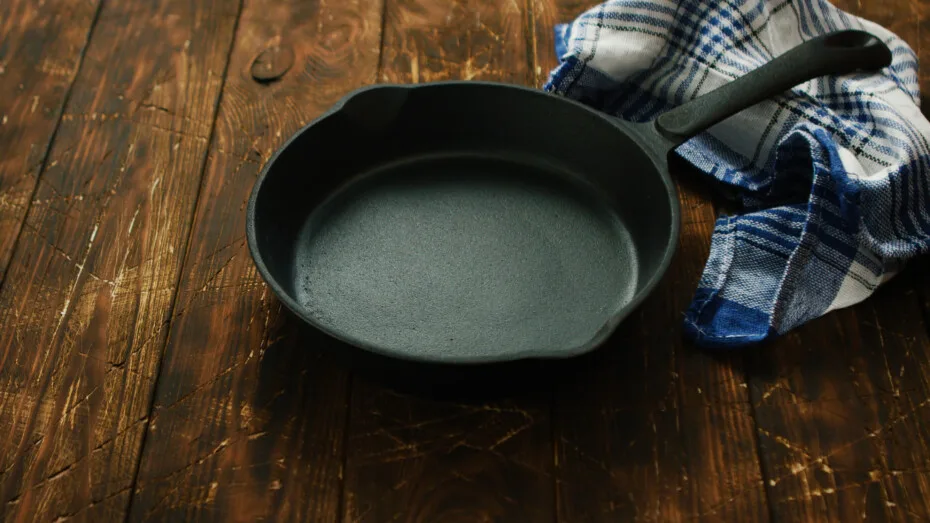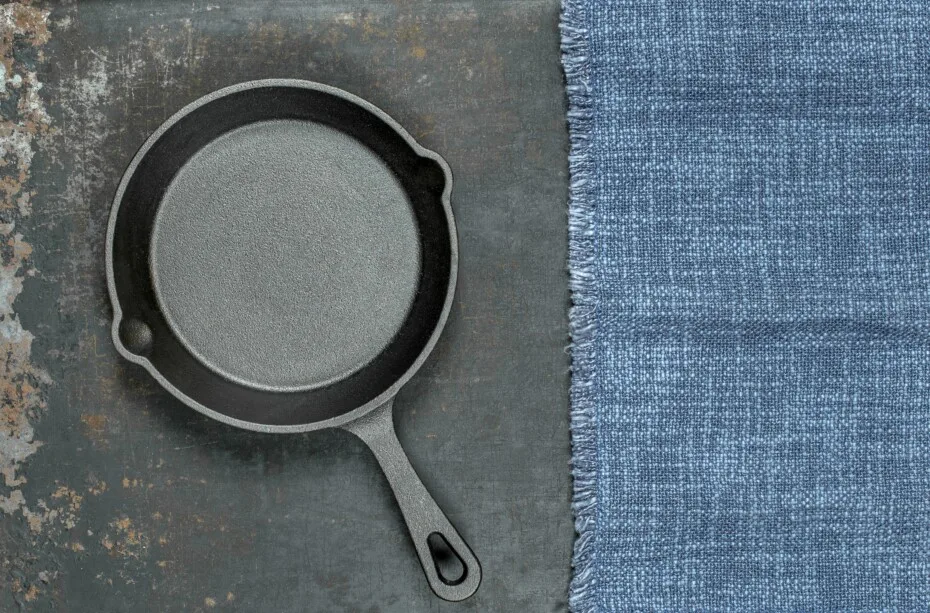Cast-iron skillets are indeed a frequent sight in many kitchens around the world. They are a very versatile kitchen staple.
You can almost cook anything in a cast-iron skillet. From eggs to steak to chicken and so much more, cast-iron skillets are the piece de resistance of the kitchen.
Before you set your cast-iron skillet over medium-high heat to create your culinary paragon, you must season it first!
Contents
- What is Seasoning?
- What Is the Best Oil To Use to Season a Cast Iron Skillet?
- How Many Times Should I Season a Cast Iron Skillet?
- Can You OverseasonA Cast Iron Skillet
- How Do You Know if a Cast Iron Skillet Is Seasoned?
- Do You Clean a Cast Iron Skillet After Every Use?
- When Should I Reseason Cast Iron Skillet?
- How To Season A Cast Iron Skillet
- Final Thoughts
What is Seasoning?
Seasoning has nothing to do with herbs and spices. In this case, seasoning acts as a homonym.
Rather than ingredients used to flavor food, seasoning a cast-iron skillet refers to the hard, black coating that gives the cast-iron skillet its signature shiny finish.
Seasoning or patina is created by the process known as the oxidization of fats.
Cast iron skillets are manufactured from iron that’s molded into the form of a skillet or pot.
With a blue-grey color, iron is a very porous material that is bound to rust when exposed to humidity.
Seasoning the skillet with oil allows the fat globules to seep into the pan’s pours.
The fat molecules then attach themselves to one another, producing a thick, solid, dry layer. Thus, creating a nonstick surface and preventing rust.
What Is the Best Oil To Use to Season a Cast Iron Skillet?
In theory, any cooking oil or fat can be used to season cast iron; however, it can vary depending on the accessibility, price, and the oil’s effectiveness.
Vegetable or canola oil, melted shortening, bacon grease, and even coconut oil are suitable oils to season your cast iron skillet with.
Some experts recommend using flaxseed oil to season cast-iron cookware. Flaxseed is known as a drying oil.
It creates a hard seal through a process called polymerization. Hence flaxseed oil is optimal for creating a nonstick surface.
On the other hand, flaxseed oil is costly, prone to flaking over time, and difficult to find.
This is why we recommend using a few drops of food ole vegetable oil. Its affordable, accessible, and does the job just as well as flaxseed oil.
How Many Times Should I Season a Cast Iron Skillet?
Seasoning a cast-iron skillet is not just a one-and-done situation. It can take all day. You must season your skillet at least four times within one setting.
Although it seems excessive, oiling the skillet, heating it, and letting it cool four times allows you to create an adequate layer of seasoning.
If you do not season your skillet correctly multiple times, you will experience rusting and foods sticking to your skillet.
Can You OverseasonA Cast Iron Skillet
In short, yes, you can overseason a cast-iron skillet. If you use too much oil, your skillet will have a tacky, sticky surface instead of a nonstick surface.
Additionally, you will have to start the entire process all over again. The bottom line is to use a small amount of fat to create a light coating.

How Do You Know if a Cast Iron Skillet Is Seasoned?
It’s all in the appearance. A cast-iron skillet that is seasoned perfectly will have a dark, semi-shiny polish that is not sticky or greasy when touched. Furthermore, rust dull or dry patches will not be present on the skillet.
Alternatively, you can also fry an egg in the skillet. Simply place a tablespoon of oil in the skillet, heat it until it is scorching hot, and add your egg.
If your cast-iron skillet is seasoned to perfection, the egg will not cling to the pan excessively.
Do You Clean a Cast Iron Skillet After Every Use?
Clean your cast-iron skillet every time you use it. While the pan is still warm, wipe the inside of the skillet with paper towels.
This will eliminate the excess food and oil on the surface of the pan.
Next, rinse the cast-iron skillet under hot running water, and scrub with a nonmetal brush or non-abrasive pad to remove food that is stuck to the pan.
When Should I Reseason Cast Iron Skillet?
After you have cleaned your skillet, it’s essential that you oil the pan again and heat it before storing it.
Luckily this process will not take very long, and your skillet will be ready to use.
First, add a few drops of vegetable oil to a paper towel, then coat the whole skillet with oil, removing any residual oil.
Place the skillet over a high flame until it is heated and almost smoking. Allow it to cool down and store it.
How To Season A Cast Iron Skillet
Most new cast-iron skillets often come preseasoned. However, it is still an excellent idea to season your cast iron skillet.
Think of it as guaranteed protection that your cast iron skillet will last for many generations to come.
Step 1: Gather Your Mise en Place
Gathering mise en place seems like an extra step, but it’s beneficial to cook a meal or season a skillet.
Gathering everything you need helps the process move along smoothly.
Step 2: Preheat the oven
Program your oven to 350°F. If you oil your skillet and place it into a cold oven, it will heat unevenly, ultimately affecting the seasoning quality.
Always preheat your oven so you can get an even layer of seasoning.
Step 3: Wash Your Cast-iron Skillet
Although this seems like a given, it is important that you wash your skillet.
Between production at the factory, sitting on a shelf in the store, and traveling to your kitchen, a lot can happen.
Typically, cast-iron skillets should only be washed with soap.
However, because the pan is going to be seasoned, it’s okay to use warm soapy water and a sponge or brush.
Step 4: Rinse and Dry
Rinse your skillet with water and dry it well the skillet with a clean, dry kitchen towel or paper towels.
Make sure there are no remaining wet spots in the skillet and that it is completely dry.
Step 5: Add Oil and Rub It In
Pour about a tablespoon or two of vegetable oil, melted shortening, or your preferred oil into the skillet.
Remember, it’s best to select an oil with a high smoking point when seasoning a skillet.
Grab a clean kitchen towel or sheet of paper towel folded into four to rub the oil on the interior and exterior of the skillet.
Step 6: Bake the Skillet and Let It Cool
Place the cast-iron skillet upside down into the oven on the center rack.
Next, place a cookie sheet or sheet of aluminum foil directly on the rack below the skillet to catch any drips.
Bake the cast-iron skillet for 1 hour, turn off the baker and let it cool thoroughly before removing it from the oven. Repeat the process three more times.
Final Thoughts
Seasoning a cast iron skillet is an easy, straightforward process. It’s a sure-fire way to ensure you get the best use out of your skillet.

I have been smoking and grilling meat from an early age and enjoy sharing my knowledge and expertise through the hundreds of articles I have written about BBQ. I hope to make everyone’s BBQ journey that little bit easier.

